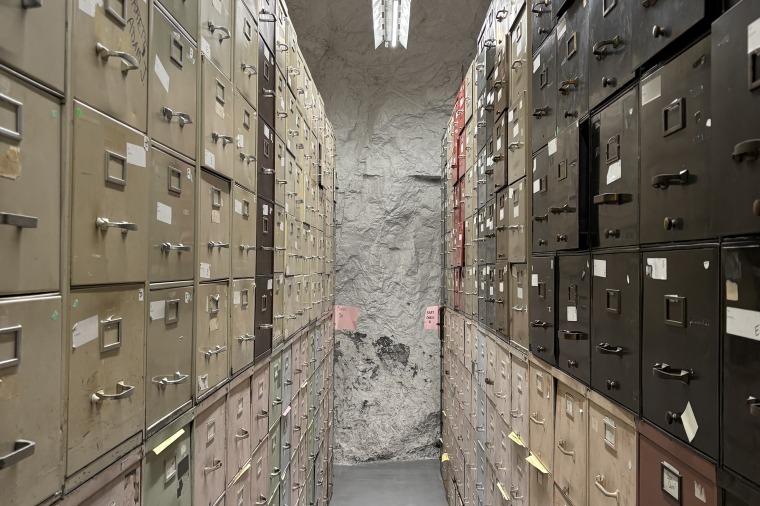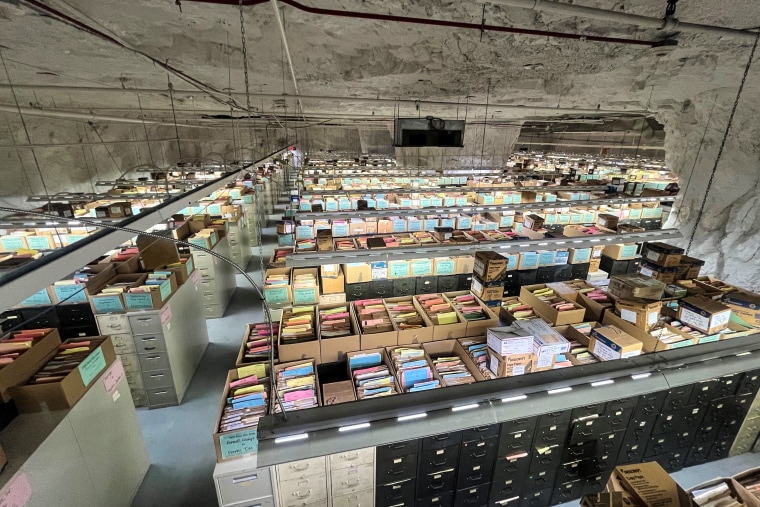BOYERS, Pa. — As you ride in a golf cart into the mouth of the Iron Mountain limestone mine, the temperature change is immediately noticeable. The natural climate control provided by the rough-hewn stone walls of the decommissioned mine — a day’s drive from the nation's capital and about an hour outside Pittsburgh — helped make it an ideal site for the federal government to process and store retirement records beginning in 1960.
Sixty-five years later, when so much is now done online, this mine is largely still how the Office of Personnel Management manages the documents of the 100,000 or so retirements from federal service each year.
Follow live politics coverage here
Processing a retirement can take months, with a single missing signature sometimes setting the task back days or weeks.
“It is still done on paper,” said Alita Haniwalt, an OPM program manager in retirement claims. “I think it becomes overwhelming because there are no two retirements that are the same.”
Over the years, the warehouse-like OPM space inside the mine — which is 220 feet underground — has accumulated more than 400 million individual records, spread across 26,000 file cabinets, in some places stacked 10 high. Cardboard boxes and paper files in manila envelopes seem to sprout from shelves and pile up on tables as they’re shuttled from station to station.

In the days following President Donald Trump’s inauguration, the mine quickly drew the attention of Elon Musk and his so-called Department of Government Efficiency. Airbnb co-founder Joe Gebbia, a Tesla board member and Musk friend, said he was recruited to the project after he walked into a meeting where it was already being discussed.
“They were talking about how it’s a place where all the papers are stored for a manual retirement process. It’s been around for decades. It’s been tried to be digitized for decades, unsuccessfully, and it’s a painful, slow process,” Gebbia said. “And they turn and look at me and go: 'Joe, you know how to build digital products with great user experience. Can you help us?'”
NBC News was granted rare and exclusive access to the mine Monday, when DOGE staffers arrived to tour it and plan the next steps in modernizing the OPM operation there.
In February, under the direction of DOGE, OPM staffers processed their first all-digital, no-paperwork federal retirement. The team was given a one-week goal, and it completed the retirement in two days.
“It really became a proof point and a rallying cry to everyone to say this is possible. Now we get to go build the product behind that and actually do something that’s scalable,” Gebbia said.
Matt MacIsaac, who runs day-to-day operations at the mine for OPM, said that while Musk’s Oval Office invocation of his workplace as a location ripe for a DOGE overhaul initially surprised him, he supported the modernization push.
“We’re ready to make this process better, make it more efficient and really get what we need for the civil servants,” said MacIsaac, who has worked for OPM since 2009 and in the mine since 2016.

Gebbia said the overhaul won’t involve closing the mine office, where 450 OPM employees work. The larger Iron Mountain facility bills itself as "a highly secure and resilient location" not only for storing records, but also as a data center.
“So the mine will always be here, and so will these paper records, but we can build a process where there’s no new paper added to the mine, step one, and step two, we can build a process where no paper has to leave the mine,” Gebbia said.
Gebbia said federal retirees could see changes as early as May 1.
"We're working at startup speed, so we're working through iterations right now, and our next one will be testing with retirees on May 1," he said. "We're moving at an incredible pace."
